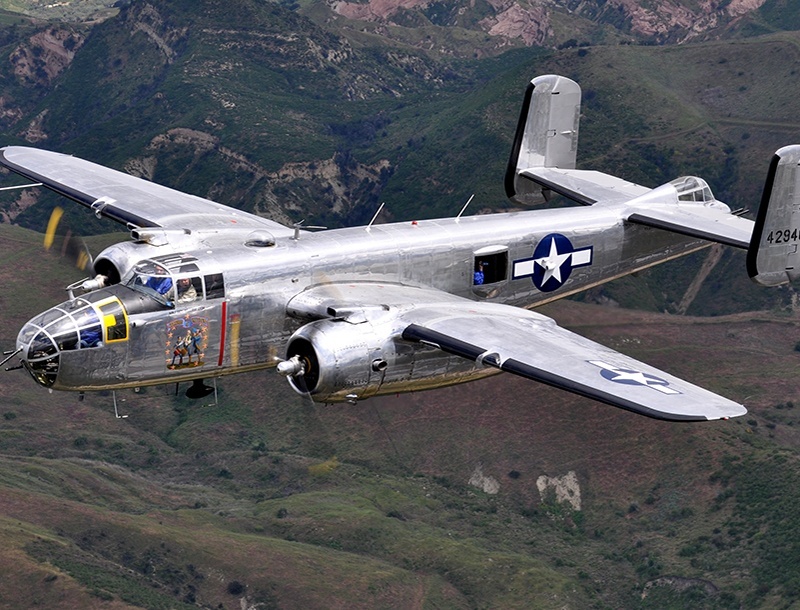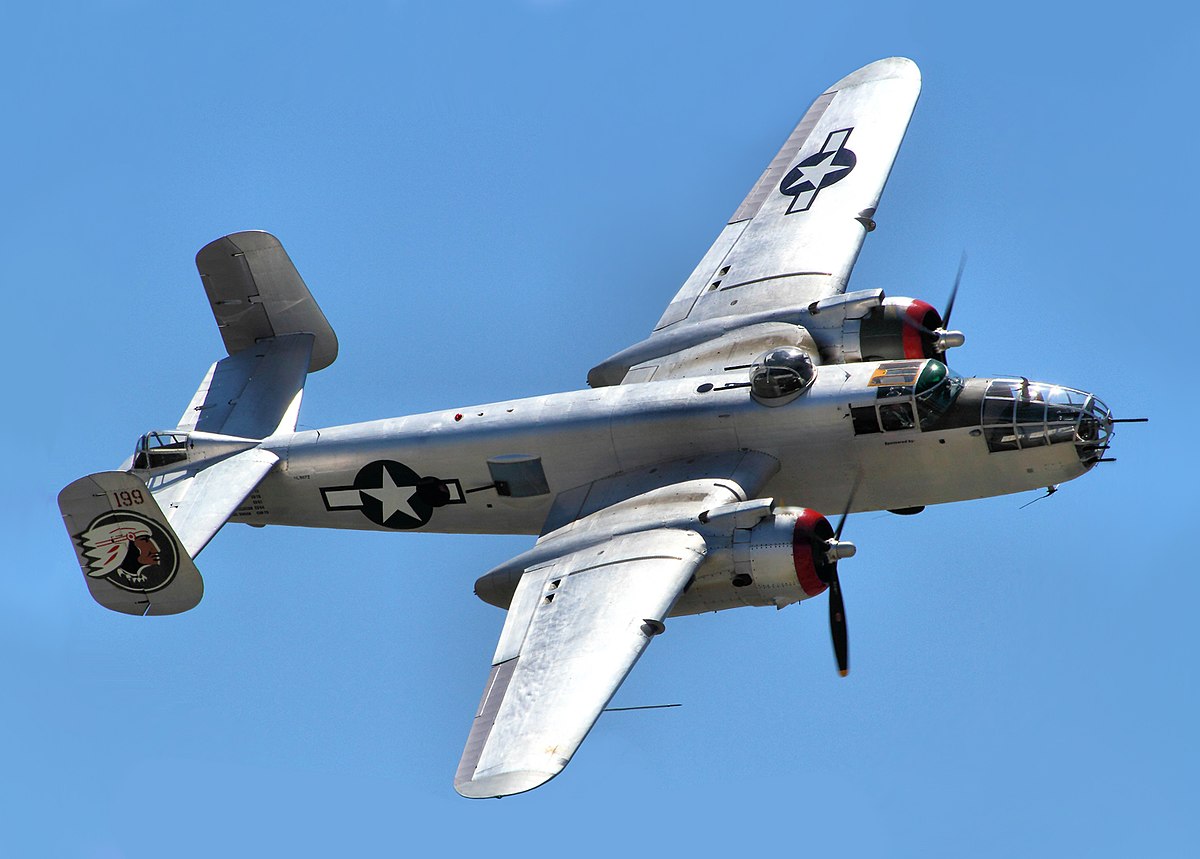The North American B-25 Mitchell is a medium bomber that played a significant role during World War II. Named after General Billy Mitchell, a pioneer of U.S. military aviation, the B-25 was renowned for its versatility, durability, and operational effectiveness in various theaters of war. It became famous for its role in the Doolittle Raid, a daring and morale-boosting bombing raid on mainland Japan early in the war.

Development and Design
The B-25 Mitchell was designed and produced by North American Aviation in response to a 1939 U.S. Army Air Corps requirement for a twin-engine medium bomber. The aircraft was designed by a team led by Dutch Kindelberger and Arthur Raymond, with the prototype flying for the first time on August 19, 1940.
The B-25 was a mid-wing monoplane with a crew of five to seven members, depending on the variant. It was powered by two Wright R-2600 Cyclone radial engines, each producing around 1,700 horsepower. The aircraft had a wingspan of 67 feet 7 inches (20.6 meters) and a length of 52 feet 11 inches (16.1 meters).
Performance and Armament
The B-25 Mitchell had a maximum speed of approximately 272 mph (438 km/h) and a range of up to 1,350 miles (2,173 kilometers), depending on the variant and mission configuration. Its service ceiling was around 24,200 feet (7,380 meters). The aircraft was armed with various combinations of defensive and offensive armament, typically including multiple .50 caliber Browning M2 machine guns mounted in dorsal, ventral, and waist positions.
In terms of payload, the B-25 could carry up to 3,000 pounds (1,360 kilograms) of bombs internally and additional ordnance on external racks. This versatility allowed it to conduct a wide range of missions, including medium-altitude bombing, low-altitude strafing attacks, reconnaissance, and anti-submarine patrols.
Operational History
The B-25 Mitchell first saw combat with the Royal Air Force (RAF) in North Africa in 1942. It quickly proved its effectiveness as a medium bomber and ground attack aircraft. However, the aircraft gained its greatest fame during the Doolittle Raid on April 18, 1942. Led by Lieutenant Colonel James Doolittle, sixteen B-25Bs launched from the aircraft carrier USS Hornet and conducted a surprise bombing raid on Tokyo and other Japanese cities. Although the raid caused minimal physical damage, it boosted Allied morale and demonstrated the vulnerability of Japan to air attack.
The B-25 continued to serve throughout World War II in various theaters, including the Mediterranean, Pacific, and China-Burma-India (CBI) theaters. It was used for bombing missions against Axis targets, maritime patrol, ground attack, and even as a transport aircraft. The B-25J, the most produced variant, introduced improvements such as a solid nose with additional forward-firing .50 caliber machine guns for strafing missions.
Variants
Over its production run, the B-25 underwent several modifications and improvements, leading to various variants:
- B-25A to B-25J: Each successive variant introduced improvements in armament, range, and performance. The B-25J was the most numerous and widely used variant, with over 4,300 produced.
- TB-25: Trainer version with dual controls for pilot training.
- PBJ: Marine Corps version configured for ground attack and anti-shipping missions.
- RAAF Mitchell: Modified B-25s used by the Royal Australian Air Force (RAAF) with additional equipment and armament.
Legacy and Post-War Service
After World War II, the B-25 Mitchell continued to serve in various roles with different air forces around the world. It saw action in the Korean War and was used by several countries for maritime patrol, reconnaissance, and even as executive transports. The aircraft’s rugged design and reliability contributed to its longevity and adaptability in post-war service.
Today, the B-25 Mitchell is celebrated for its role in World War II and is a popular choice for airshows and aviation museums. Several restored examples are still airworthy and regularly participate in commemorative flights and events, honoring its historical significance and the legacy of the crews who flew them.
Conclusion
The North American B-25 Mitchell stands as a testament to the ingenuity and engineering prowess of its designers and manufacturers. Its versatility, durability, and operational effectiveness made it a vital asset for Allied forces during World War II. From the daring Doolittle Raid to its widespread use in bombing and ground attack roles, the B-25 played a crucial part in Allied air campaigns. Its enduring legacy continues to be celebrated today, reminding us of its pivotal role in shaping the course of history during one of the most significant conflicts of the 20th century.

